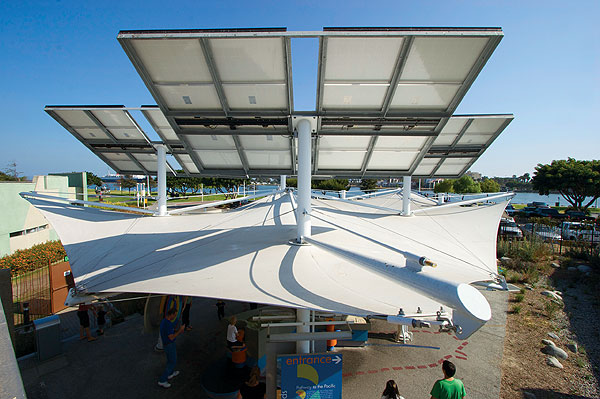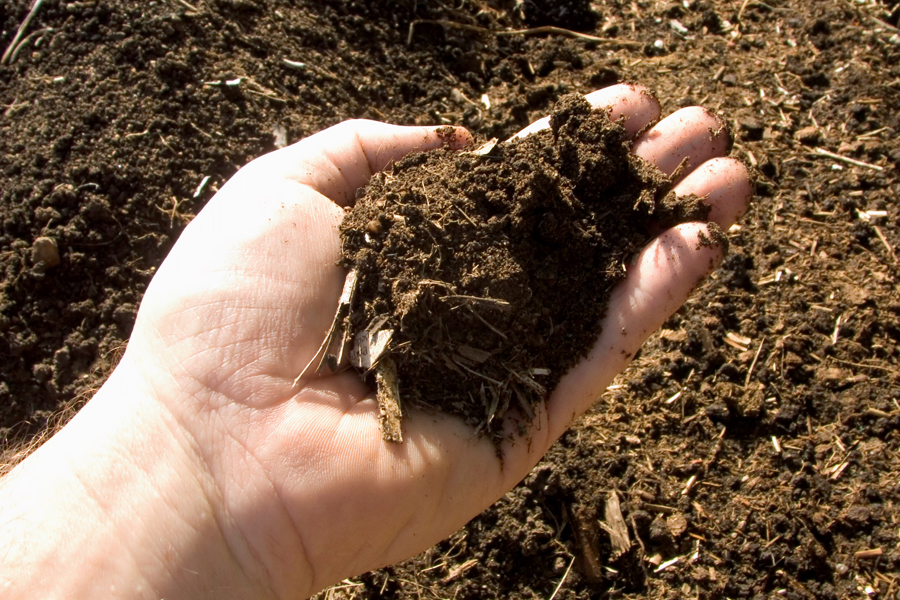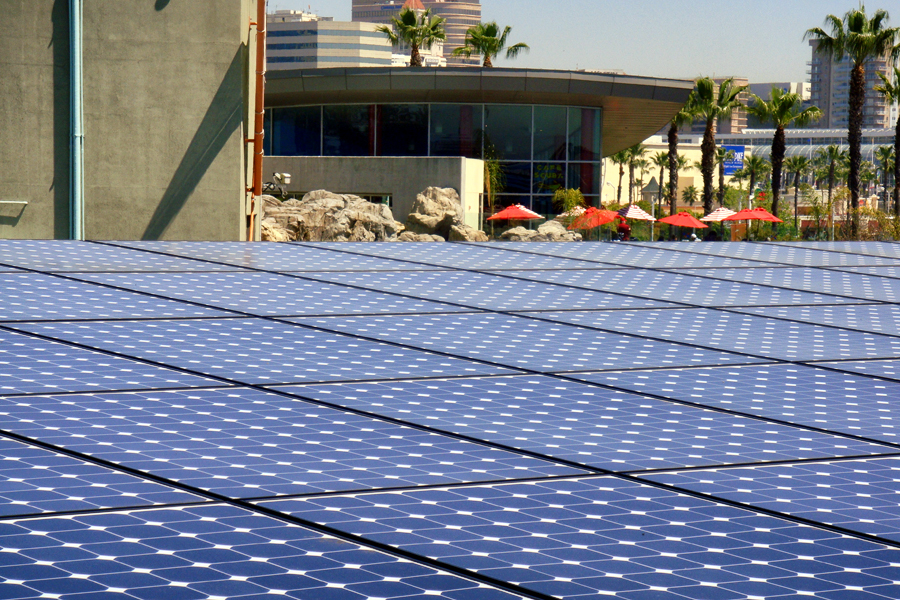Reducing Our Carbon Footprint
The Aquarium reduces its carbon footprint by tackling initiatives to save on energy, fossil fuel, food, and purchasing.

Solar panels above Watershed exhibit
The Aquarium is a member of The Climate Registry, a voluntary, non-profit program for registering greenhouse gas emissions. The Aquarium was the first museum in the United States to certify its greenhouse gas emissions inventory. It has been a Climate Action Leader since 2007, reducing its emissions and carbon footprint by 50% since first reporting. The Aquarium reduces its carbon footprint by tackling initiatives to save on energy, fossil fuel, food, and purchasing. This is what we do. This is what you can do.
Energy
What we do
- The Aquarium is committed to keeping the overall energy usage constant while at the same time attendance and the number of exhibits increases.
Maintaining the temperature of each of the Aquarium’s more than 50 exhibits is our largest energy demand. Adding control devices such VSDs (Variable-Speed Drive) and a DPS (Differential Pressure Switch) helps reduce excess pumping. The result is a more efficiently operating central plant. Insulating our pipes and life support systems also help reduce energy needs. - The Aquarium is dedicated to raising “green technology” awareness and to investing in sustainable practices such as solar panels.
A total of 46kW of solar panels have been installed at three Aquarium locations. A fuel cell system installed in 2019 allows the Aquarium to produce more than 80% of its energy needs on-site. The Aquarium was a beta test site for Siemen’s building management system. The system has resulted in an annual savings of 800,000kWh.
What you can do
- There are many ways to reduce energy consumption at home.
In California, lighting makes up about 20% of your energy costs. You can save 75% of that energy by replacing incandescent bulbs with compact florescent bulbs (CFLs) or LED lights. For other energy saving tips visit Energy Upgrade California. - Consider installing high efficiency ceiling fans in your home.
Ceiling fans can save up to 40% in air conditioning costs. Or consider using such fans together with air conditioning—a ceiling fan will allow you to raise the thermostat setting about 4°F with no reduction in comfort.
Fossil Fuel
What we do
- The Aquarium uses a fleet of vehicles ranging from GEM® carts to trucks for daily operations.
This fleet includes fuel efficient natural gas powered vehicles and electric GEM® carts. - The Aquarium purchases carbon offsets to counteract the greenhouse gas (GHG) emitted by its fleet of vehicles.
Since we cannot eliminate the emissions of the vehicles we purchase carbon offsets.
Carbon offset are systems that allow individuals and companies to invest in environment projects in order to balance out their own carbon footprint. These projects reduce future emissions and include initiatives such as implementation of renewable energy technologies or planting of trees to soak up CO2.
What you can do
- Half of our CO2 comes from vehicles so carpool, use mass transit, bike or walk to work.
For every mile of driving you eliminate, you save one pound of carbon dioxide (CO2). - Idling cars during traffic use a great dealt of fuel.
If possible, choose to drive at non-peak traffic times. You will get to your destination faster while using less fuel. Also if are stopped for more than 10 seconds while waiting at a drive-through or picking up children from school, turn off your engine.
Food
What we do
- The Aquarium grows live food such as brine shrimps, mysid shrimps, and algae for its animal collection.
An edible garden also helps to feed our terrestrial birds and reptiles. - We compost! The Aquarium eliminates all the organic food waste produced by visitors and staff.
Composting bins are provided throughout the Aquarium to divert organic food waste and compostable items to a composting facility off-site. This effort helps eliminate the methane production that would have generated if the food waste was sent to a landfill.
What you can do
- Consider joining the Meatless Monday Movement!
Studies show that meat production produces significantly more greenhouse gas emissions that vegetables. Universities, companies, and school districts are joining this effort to reduce meat consumption for this reason. You can choose to go meatless every Monday to help the environment. - Visit your local farmer’s market often.
Prices are often lower and while purchasing supports local farmers, it also reduces carbon emissions. Less fuel is used by a farmer to get to a local market than is required to transport produce great distances by truck or air. - Consider composting at home.
Your city may offer composting classes and supplies at low cost as City of Long Beach does. You can even compost very simply by doing a DIY project.
Purchasing
What we do
- We significantly reduced use of paper throughout the Aquarium.
Efforts are ongoing to print less, provide online materials such as Aquarium magazines, visitors guide, and annual reports, online fundraising appeals, and paperless grant submissions. When printing is necessary, every effort is made to use paper that has a significant recycled content, Forest Stewardship Council certification, and soy ink. - The Aquarium strives to minimize our impact on natural resources by purchasing sustainable products.
One example is the sustainable seafood provided to visitors and staff in Café Scuba, the staff cafeteria, and at catered events. For the Aquarium’s animals’ health and for a healthy ocean, we try to find the most sustainable seafood possible that best matches our animals’ dietary needs.
What you can do
- Encourage your employer to purchase office supplies that are green, sustainable choices.
Most major suppliers have an environmentally-friendly list to choose from a similar, and sometimes lower, prices than the regular merchandise. - Learn more about sustainable seafood by visiting the Aquarium’s Seafood for the Future website and NOAA’s FishWatch for healthy, sustainable seafood choices.
Ask your restaurant server or seafood supplier where the seafood came from and which choices are better for you healthwise and for the environment.

Consider composting at home. Your city may offer composting classes and supplies at low cost as City of Long Beach does. You can even compost very simply by doing a DIY project.

A total of 46kW of solar panels producing 64,000kWh of electricity have been installed at three Aquarium locations.



